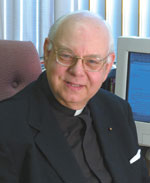Easter Sunday of the Resurrection of the Lord / Msgr. Owen F. Campion
The Sunday Readings
 A variety of biblical readings occurs in the course of liturgical celebrations for Easter. For instance, the liturgy of the word for the Easter Vigil celebrated on the night of Holy Saturday is unsurpassed among all the feasts of the year.
A variety of biblical readings occurs in the course of liturgical celebrations for Easter. For instance, the liturgy of the word for the Easter Vigil celebrated on the night of Holy Saturday is unsurpassed among all the feasts of the year.
These reflections center upon the readings for the Eucharist celebrated on Easter Sunday.
The first reading is from the Acts of the Apostles. As this season continues, often the Church will draw from Acts its first scriptural reading. In this reading, St. Peter addresses a crowd in Jerusalem. His sermon, one of several in the early chapters of Acts, capsulized the Gospel message.
Jesus is Lord. John the Baptist foretold the coming of Jesus. Jesus was the gift and representative of God. He died on Calvary for the sins of all humanity.
After dying on Calvary, Jesus rose and was seen by witnesses. The Lord sent the surviving Apostles to proclaim the Gospel as they went into places far and near.
The reading, while crisp and not too long, focuses attention upon the Lord. Jesus redeemed the world in his crucifixion. He then rose from the dead. The resurrection is more than a pious assertion of some vague, unearthly way to say that the Lord’s power endures from age to age through Christianity and its adherents. Jesus rose from the dead in time and space. Witnesses saw the risen Lord.
St. Paul’s Epistle to the Colossians provides the second reading. Paul calls the Christians of Colossae to turn to Jesus. They are with the Lord. The Lord is with them. Such is the effect of the incarnation, of the redemption and of the personal decision to turn to God.
The Gospel of St. John furnishes the last reading. It is a triumphant account of Jesus’ resurrection, revealing the excitement in which it was written. Mary Magdalene, forever faithful, discovered that Jesus’ tomb is empty. She immediately alerted Peter and the other Apostles to her discovery.
Peter and the Beloved Disciple hurried to see for themselves. The Beloved Disciple saw the empty tomb and remembered the Lord’s prophecy of rising from the dead.
Reflection
The readings make clear that, for believers, Easter is the greatest of days, remembering that spectacular moment—unique among all humans—when the Lord, dead after being cruelly crucified, literally returned to earthly life.
No other day surpasses Easter in Christian worship and expression. This has been true since the event itself.
Christians have reflected upon it, sung about it and dreamed about it. And from their dreams emerged the “Easter bunny.”
It is a legend, but it has a message.
Supposedly, when Jesus magnificently returned to life, it was early in the morning. The only animal present and awake in the garden was a rabbit.
Rabbits were drab and ugly, fur too dark, ears too large. They hid in the shadows. For the rabbit present at the Resurrection, the sight completely bleached its fur, becoming pure white.
Its behavior changed. It was docile and gentle. Instead of hiding, it anxiously, longingly and hopefully searched its surroundings, yearning for the Lord’s return. He will return! Its apparent nervousness is only a disguise for hope to see Jesus again, its gentleness a sign of openness to Jesus.
The legend—who knows if it has fact behind it—teaches us that knowing Jesus should transform us. He gives us a new set of values, perceptions and goals. He can make us beautiful. He lives! Now! He loves us. He still is heard in the Scriptures. He still is to be found in prayer and the sacraments.
Rejoice! Pray to share the experience and response of Easter. Seek to love as if, after encountering the loving Lord, life is forever changed for the better. †
 A variety of biblical readings occurs in the course of liturgical celebrations for Easter. For instance, the liturgy of the word for the Easter Vigil celebrated on the night of Holy Saturday is unsurpassed among all the feasts of the year.
A variety of biblical readings occurs in the course of liturgical celebrations for Easter. For instance, the liturgy of the word for the Easter Vigil celebrated on the night of Holy Saturday is unsurpassed among all the feasts of the year.